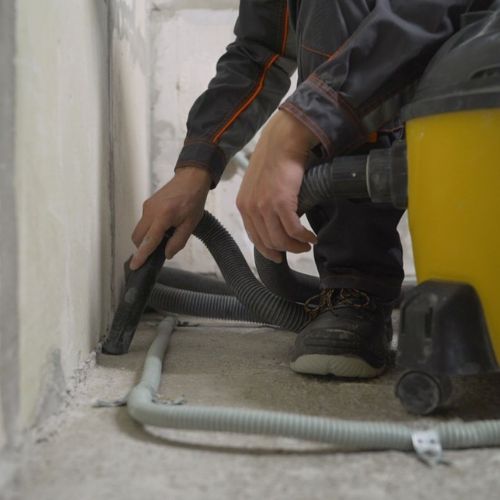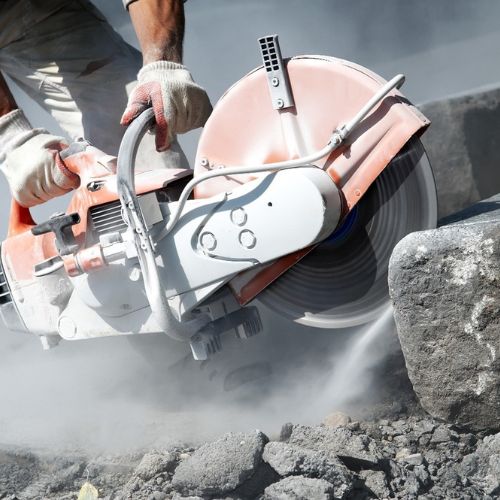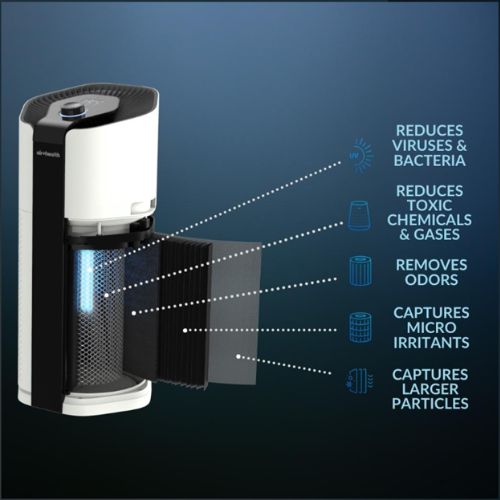In both new construction and renovation, things can get messy — and we’re not just talking about the floor. When

you’re sawing wood, cutting plaster or spraying paint, harmful particulates are released into the air on a large scale. And the closer a project gets to completion, the harder it is to properly ventilate the space.
A construction site air purifier is a must for controlling airborne particles. By trapping and removing contaminants, you won’t just be looking out for your workers — you’ll also be improving air quality for the eventual occupants. Air Health has everything you need to know about the benefits of an air purifier for new construction sites.
Air Purifier for Construction Dust
The most commonly-known air contaminant on a construction site is dust — mainly because it’s the most visible. Even people who don’t work in the industry have driven past a construction site and seen the dust kicked in the air.
But these particles aren’t just an annoyance. They also can cause short-term and long-term health problems. Working in construction has been linked to an increased risk of COPD, emphysema, asthma, lung cancer and other respiratory issues. Certain dust types are also considered an environmental hazard.

There are three types of dust you’ll find most often on a construction site:
- Wood Dust — The most common and recognizable dust. It can come from hardwood, softwood, MDF or plywood.
- Silica Dust — This is the dust caused by cutting or grinding concrete, sandstone and mortar. It’s the most dangerous type of dust.
- Low-Toxicity Dust — General dust caused by everything from drywall to limestone. It’s the least dangerous dust but is by no means safe.
Removing as much dust as possible from the air will reduce health and safety risks — not to mention making clean-up easier. In addition to having as much ventilation as possible and wearing protective gear (filtration masks, etc.) using an air purifier is a must for new construction jobs.
How a Construction Air Filter Helps with Dust
Construction air purifiers such as the Air Health SKYE use a HEPA filter, which is short for “High Energy Particulate Air" filter. These filters were first developed during World War II for soldiers and scientists, and they’ve been used commercially since the 1950s.

To be classified as a HEPA filter by the U.S. Department of Energy (DOE), a filter must trap at least 99.97% of airborne particulates that are 0.3-microns in diameter, which is considered the worst-case size — i.e., the most likely to be breathed in. This is measured at an airflow of 85 liters per minute. You’ll also want a filter with a good Minimum Efficiency Reporting Value (MERV) rating, which measures its ability to trap particles larger and smaller than this 0.3-micron threshold.
As a mechanical filtration system, HEPA air purifiers work by using an electric fan to force air through the fine mesh filter. Particulates are captured and contained while clean air flows back into the room. Each purifier is rated for a certain airflow rate, which is measured in cubic feet per minute (CFM), and to cover a certain square footage. While you should always err on the side of a slightly larger filtration system, this is especially true on a construction site where there are far more airborne particles than in completed buildings.
HEPA filters are considered the most efficient filtration method for all kinds of dust, making it essential on a job site. Our SKYE Portable Air Filter is rated to cover up to 1,600 square feet in 30 minutes and 3,200 square feet in 1 hour and has a MERV rating of 13, which means it is excellent at filtering all particles between 0.1 and 10 microns. Be sure to keep some spare filters on hand so you can handle tough jobs on the fly.
Other New Construction Air Quality Concerns
Dust isn’t the only airborne hazard to be concerned about. Many materials used in new construction can release volatile organic compounds (VOCs) into the air, which significantly hurt air quality — and are potentially toxic in large quantities. Some of these materials include:
- Paint and stains
- PVC plastics
- Flooring that has off-gassing — includes vinyl, laminate, and engineered wood
- Glue and other adhesives
- Spray foam

Two of the most common VOCs found on construction sites are formaldehyde and toluene. Formaldehyde is often present in off-gassing flooring, and even in low amounts, it can cause coughing, wheezing, eye and nose irritation and other symptoms. Toluene is common in paint, cleaning products and adhesives — it’s what produces the “huffing high”. Some of the other toluene exposure symptoms include confusion, dizziness, insomnia, and anxiety.
Even without considering the physical and mental dangers, these materials and others (such as carpeting) also release unpleasant odors into the air. Left unchecked, some odors take weeks, months or even years to go away. While not necessarily harmful, these odors are at minimum an annoyance to workers and future occupants.
Using Air Purifiers for VOCs & Odor
Whenever possible, you should use low-VOC or VOC-free paints, adhesives and flooring. Still, sometimes materials with VOCs are unavoidable. Mitigating these dangers is a huge benefit of construction site air purifiers. Choose an air purifier that goes beyond just dust control.
In addition to the H-13 HEPA filter, the SKYE 5-Stage Air Purifier has several other filtration systems. An activated carbon filter removes odors from the air. Our patented PRO-cell technology specifically targets VOCs, gases and chemical odors so they’re gone in hours instead of years. There’s also a pre-filter for large particles and UV-C germicidal lamps to reduce germs, fungi and mold.
Air quality is important in every industry — but especially in new construction where there are everyday hazards. An Air Health construction air purifier will greatly improve short-term air quality for long-term worker and occupant health.
 US Dollars
US Dollars
